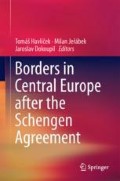Abstract
The Schengen phenomenon is one of the most significant examples of the process of the declining importance of states and state (national) identities as well as the growing meaning of regional (in the concept of the Europe of regions) and international or global structures. The removal of border checks and the ability to cross borders anywhere resulted in a significant change in the conditions both for institutions and for people living in border areas. We want to refer this changes especially in the five model Central European border areas (Euroregions): Elbe/Labe, Šumava/Bayerischer Wald-Unterer Inn/Mühlviertel, Silva Nortica, Bílé/Biele Karpaty and Praděd/Pradziad. We carried out the survey with the help of students working as interviewers in the field in total with almost 3,300 respondents. This introductory chapter presents the summaries of the following chapters as well.
Access this chapter
Tax calculation will be finalised at checkout
Purchases are for personal use only
References
Dostál, P. (2000). Reintegrating Central European region: Challenges of trans-border spatial development. Acta Universitatis Carolinae. Geographica, 1, 21–38.
Drgoňa, V. (1999). Pohraničné územia SR - regionálna komparácia. Sborník příspěvků ze VII. ročníku konference Česká a slovenská geografie na přelomu tisíciletí, 36–42.
Jeřábek, M., Dokoupil, J., Havlíček, T. et al. (2004). České pohraničí - bariéra nebo prostor zprostředkování? Academia Praha, 297 pp.
Jurczek, P. (Ed.). (1996). Regionale Entwicklung über Staatsgrenzen. Das Beispiel der EUREGIO Egrensis. Kommunal- und Regionalstudien, 23, 148 pp.
Lauko, V. (2001). Postavenie pohraničnej oblasti juhozápadneho Slovenska v regionálnom rozvoji SR. Miscellanea Geographica Universitatis Bohemiae Occidentalis, 9, 213–220.
Leimgruber, W. (1980). Die Grenze als Forschungsobjekt der Geographie. Regio Basiliensis, XXI(1/2), 67–78.
Newmann, D. (2001). Boundaries, borders and barriers: Changing geographic perspectives on territorial lines. In L. Albert (Ed.), Identities, borders and orders, rethinking international relations Tudory (pp. 137–150). Minneapolis: University of Minnesota Press.
Schamp, E. W. (1995). Die Bildung neuer grenzüberschreitender Regionen im östlichen Mitteleuropa - eine Einführung. Frankfurter Wirtschafts- und Sozialgeographische Schriften, 67, 1–18.
Scott, J. W. (2011). Borders, border studies and EU enlargement. In D. Wastl-Walter (Ed.), The Ashgate research companion to border studies, Vol. 7, pp. 123–142.
Szmagalska-Follis, K. (2009). Are the European Union’s new boundaries like the Iron curtain? 1989, borders and freedom of movement in Poland and Ukraine. International Journal of Politics, Culture, and Society, 22(3), 385–400.
Zaiotti, R. (2011). Cultures of border control: Schengen and the evolution of European Frontiers (p. 263). Chicago and London: The University of Chicago Press.
Acknowledgements
The book is the result of research findings sponsored by the Academy of Science of the Czechia: No. IAA311230901, ‘Czech borderland after Schengen: self-sufficient, oscillatory or transit region?’ and by the Grant Agency of the Czechia No. P410/12/G113, ‘Historical Geography Research Centre’.
Author information
Authors and Affiliations
Corresponding author
Editor information
Editors and Affiliations
Rights and permissions
Copyright information
© 2018 Springer International Publishing AG
About this chapter
Cite this chapter
Jeřábek, M., Havlíček, T., Dokoupil, J. (2018). Introduction. In: Havlíček, T., Jeřábek, M., Dokoupil, J. (eds) Borders in Central Europe After the Schengen Agreement. Springer, Cham. https://doi.org/10.1007/978-3-319-63016-8_1
Download citation
DOI: https://doi.org/10.1007/978-3-319-63016-8_1
Published:
Publisher Name: Springer, Cham
Print ISBN: 978-3-319-63015-1
Online ISBN: 978-3-319-63016-8
eBook Packages: Social SciencesSocial Sciences (R0)

